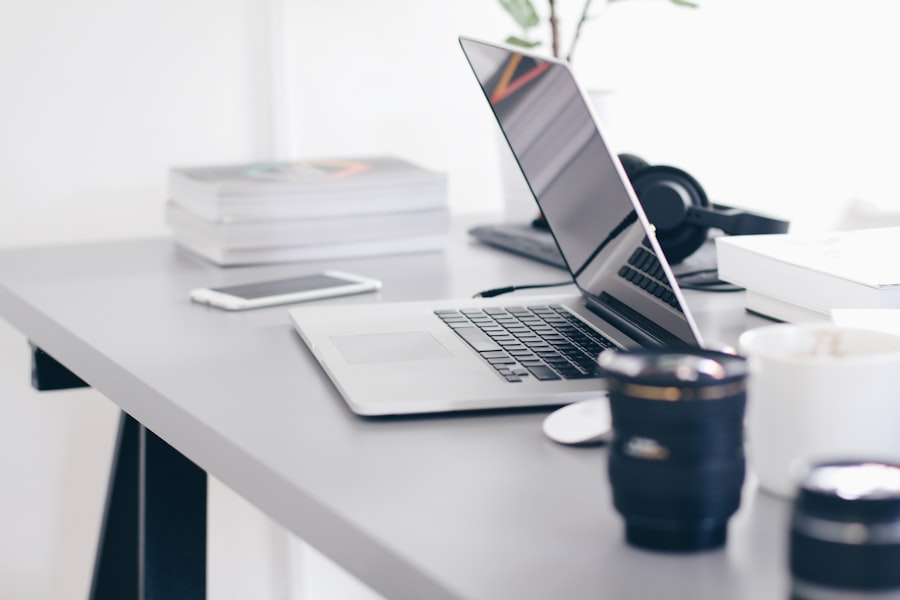A functional workspace is essential for fostering productivity and creativity, particularly in an era where remote work and flexible office arrangements have become the norm. The design and organization of a workspace can significantly influence an individual’s ability to focus, manage tasks efficiently, and maintain a positive mindset. A well-structured environment not only enhances workflow but also contributes to overall job satisfaction.
When individuals feel comfortable and organized in their workspace, they are more likely to engage deeply with their tasks, leading to higher quality output and a greater sense of accomplishment. Moreover, the importance of a functional workspace extends beyond mere aesthetics. It encompasses the psychological aspects of work as well.
A cluttered or poorly designed workspace can lead to distractions, stress, and even burnout. Conversely, a thoughtfully arranged area can promote clarity of thought and a sense of control over one’s work. This is particularly crucial in small spaces where every inch counts; maximizing functionality while minimizing chaos is key.
By prioritizing the design and organization of a workspace, individuals can create an environment that not only supports their professional goals but also nurtures their well-being.
Key Takeaways
- A functional workspace is essential for productivity and efficiency
- Designing a small desk for efficiency involves maximizing space and minimizing clutter
- Organizational tools such as desk organizers and file holders are crucial for small desks
- Utilizing vertical space for storage can help maximize the use of limited space
- Ergonomic considerations are important for small workspaces to prevent discomfort and injury
Designing a Small Desk for Efficiency
Assessing User Needs
When designing a small desk, the first step is to understand the specific needs of the user. This involves identifying the tasks that will be performed at the desk, which can guide decisions about its size, shape, and features. For example, someone who primarily works on a laptop may require less surface area than someone who needs space for multiple monitors or extensive paperwork.
Optimizing Desk Layout and Storage
A compact desk with built-in storage solutions can help keep essential items within reach while minimizing clutter. The layout of the desk is also crucial, with options like corner desks maximizing space utilization while providing ample surface area for work materials. Alternatively, a wall-mounted desk can free up floor space and create an open feel in a small room.
Material and Color Choices
The choice of materials and colors can also impact the overall functionality of the desk. Lighter colors can make a small space feel larger, while durable materials ensure longevity and ease of maintenance. Ultimately, the goal is to create a workspace that not only meets practical needs but also inspires creativity and focus.
Organizational Tools for Small Desks

Organizational tools are vital for maintaining order in small desks, where space is at a premium. Desk organizers, such as trays and caddies, can help categorize items like pens, paper clips, and sticky notes, making them easily accessible without taking up too much space. For documents that require frequent access, vertical file holders can be an excellent solution, allowing users to keep important papers upright and visible without cluttering the desktop.
In addition to traditional organizers, digital tools can also play a significant role in maintaining organization. Task management apps and digital calendars can help streamline workflows by keeping track of deadlines and appointments without the need for physical planners or sticky notes that can quickly overwhelm a small desk. By integrating both physical and digital organizational tools, individuals can create a cohesive system that enhances efficiency and reduces stress in their workspace.
(source: Forbes)
Utilizing Vertical Space for Storage
In small workspaces, utilizing vertical space is crucial for maximizing storage without sacrificing floor area. Wall-mounted shelves are an excellent option for storing books, files, or decorative items that inspire creativity. By elevating storage off the desk surface, individuals can free up valuable real estate for essential work tasks.
Floating shelves can be particularly effective as they provide a sleek look while offering flexibility in arrangement. Another innovative way to utilize vertical space is through pegboards or wall grids. These versatile tools allow users to hang various items such as tools, office supplies, or even plants, creating an organized yet visually appealing display.
This not only keeps items within easy reach but also adds a personal touch to the workspace. By thinking vertically, individuals can transform their small desks into efficient workstations that feel spacious and organized.
Ergonomic Considerations for Small Workspaces
Ergonomics is an essential aspect of designing any workspace, but it becomes even more critical in small environments where comfort may be compromised due to limited options. An ergonomic setup helps prevent strain and injury while promoting productivity. Key considerations include desk height, chair support, and monitor positioning.
Ideally, the desk should allow the user to maintain a neutral wrist position while typing, with elbows at approximately 90 degrees. Choosing an adjustable chair is another vital component of an ergonomic workspace. A chair that provides lumbar support and allows for height adjustments can significantly enhance comfort during long working hours.
Additionally, monitor placement should be at eye level to reduce neck strain; using monitor risers or adjustable arms can help achieve this in tight spaces. By prioritizing ergonomic principles in small workspaces, individuals can create environments that support their health and productivity over time.
Multi-functional Furniture for Small Desks

Desks with a Dual Purpose
In small workspaces, desks that incorporate storage solutions are a game-changer. They provide both workspace and storage in one compact unit, maximizing utility without overwhelming the area with excess items. For example, a desk with built-in shelving allows users to keep books or supplies close at hand while maintaining an organized surface.
Foldable and Extendable Options
Another innovative approach is to consider foldable or extendable furniture options. A drop-leaf table can serve as a desk when needed but can be tucked away when not in use, freeing up space for other activities. Similarly, ottomans with hidden storage compartments can double as seating while providing additional space for stowing away office supplies or personal items.
Creating Adaptable Workspaces
By selecting multi-functional furniture pieces, individuals can create adaptable workspaces that cater to their changing needs without sacrificing style or comfort. This approach enables individuals to make the most of their limited space, ensuring a productive and organized work environment.
Creating a Distraction-Free Environment
A distraction-free environment is paramount for maintaining focus and productivity in any workspace, especially in smaller settings where external stimuli may be more pronounced. One effective strategy is to establish clear boundaries between work and personal life; this could involve designating specific hours for work or creating physical barriers that signal when one is “in the zone.” Noise-canceling headphones or soft background music can also help drown out distractions from surrounding activities. Additionally, decluttering the workspace is essential for minimizing distractions.
Keeping only essential items on the desk reduces visual noise and allows individuals to concentrate on their tasks more effectively. Implementing a “one in, one out” rule for new items entering the workspace can help maintain this level of organization over time. By consciously creating an environment that prioritizes focus and minimizes interruptions, individuals can enhance their productivity levels significantly.
Tips for Maximizing Productivity in a Small Workspace
Maximizing productivity in a small workspace requires intentional strategies that cater to individual working styles while optimizing available resources. One effective approach is to establish a daily routine that includes designated times for focused work sessions interspersed with short breaks. Techniques such as the Pomodoro Technique—working for 25 minutes followed by a 5-minute break—can help maintain energy levels and prevent burnout.
Another key tip is to leverage technology effectively; utilizing productivity apps can streamline task management and keep users accountable to their goals. Setting reminders for deadlines or using time-tracking software can provide insights into how time is spent throughout the day, allowing for adjustments as needed. Furthermore, personalizing the workspace with motivational quotes or images can serve as constant reminders of goals and aspirations, fostering an environment conducive to sustained productivity.
In conclusion, creating an efficient and functional workspace within limited dimensions involves thoughtful design choices, effective organizational strategies, and ergonomic considerations tailored to individual needs. By embracing multi-functional furniture and maximizing vertical space while minimizing distractions, individuals can cultivate environments that not only support their professional endeavors but also enhance their overall well-being and satisfaction in their work lives.
If you are looking to upgrade your office space with a small desk, you may also be interested in exploring the benefits of executive desks. Executive desks offer a more sophisticated and professional look to any workspace, providing ample storage and workspace for productivity. Check out this article on upgrading your office with executive desks for more information on how to elevate your office design.
FAQs
What is a small desk?
A small desk is a compact piece of furniture designed for use in smaller spaces, such as apartments, dorm rooms, or home offices. It typically features a smaller surface area and may have built-in storage to maximize functionality in a limited space.
What are the benefits of a small desk?
A small desk is ideal for individuals who have limited space but still need a designated area for work or study. It can help create a functional workspace without taking up too much room, and it can also be a stylish addition to a smaller living area.
What are the different types of small desks available?
There are various types of small desks available, including writing desks, computer desks, corner desks, and wall-mounted desks. Each type is designed to maximize space and functionality while catering to different needs and preferences.
How do I choose the right small desk for my space?
When choosing a small desk, consider the dimensions of your space, the specific purpose of the desk (e.g., writing, computer work), and any additional features you may need, such as storage or built-in cable management. It’s also important to consider the style and design of the desk to ensure it complements your existing decor.
Where can I purchase a small desk?
Small desks can be purchased from furniture stores, home goods retailers, online marketplaces, and office supply stores. Many retailers offer a variety of options to suit different styles, budgets, and space requirements.


